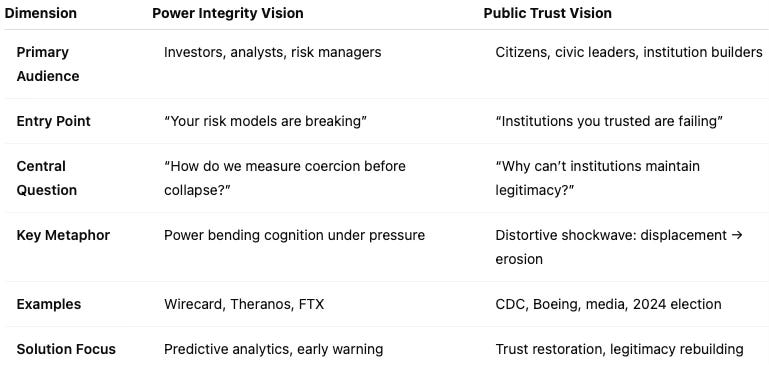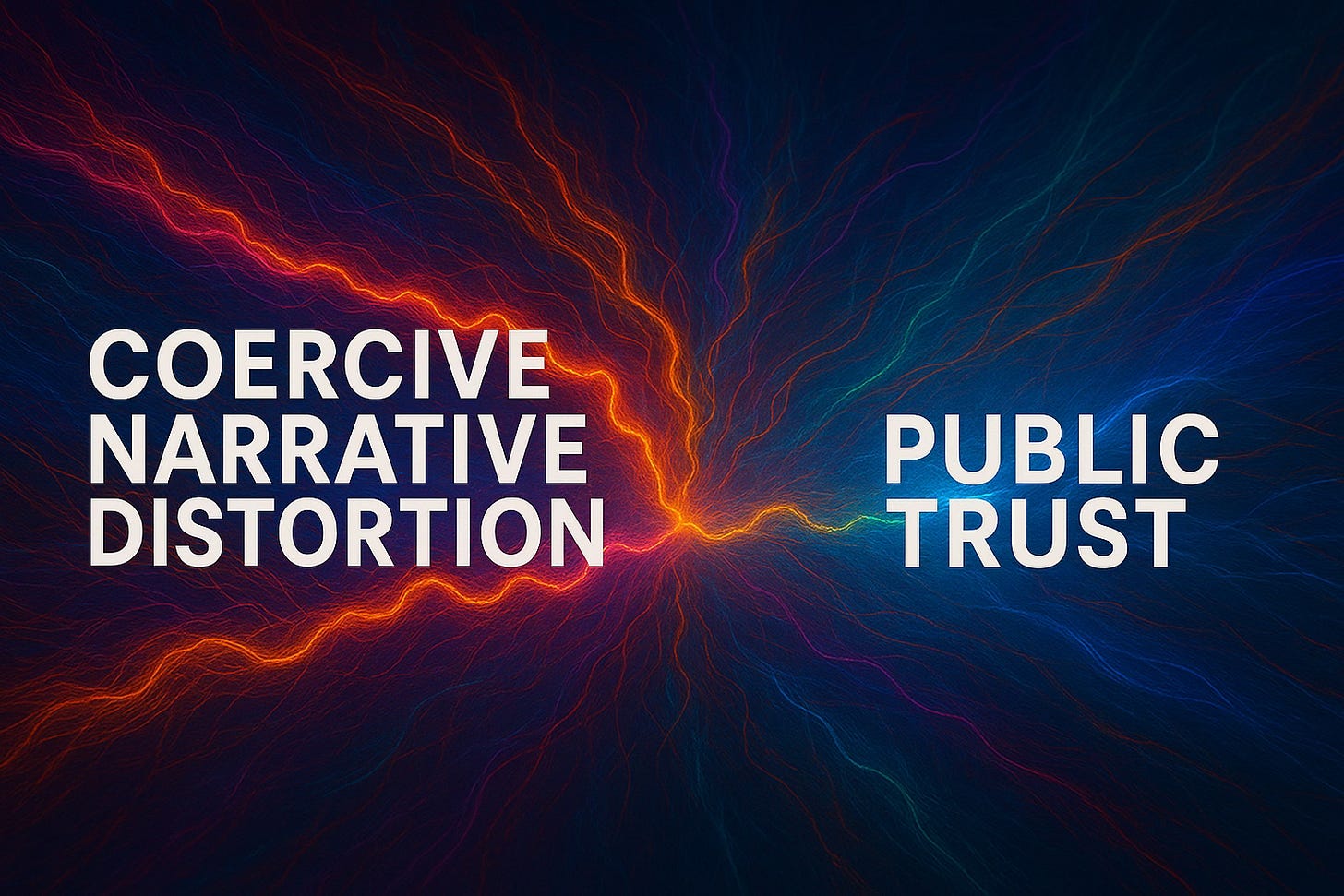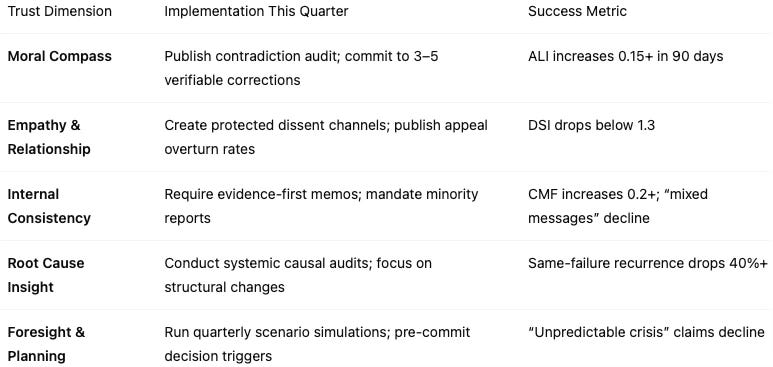MCAI Culture Vision: Coercive Narrative Shock and The Displacement of Public Trust
How MindCast AI Measures, Forecasts and Helps Restore Trust in a Culture of Coercive Narrative Governance
See also MCAI Culture Vision: Discretion and the Architecture of Systemic Trust (Oct 2025).
I. The Trust Crisis You’re Watching
Trust used to accumulate slowly—built through consistent action, maintained through transparency, lost only through spectacular betrayal. The timeline was generational. Today that timeline has collapsed. Now institutions hemorrhage legitimacy overnight while operations appear unchanged. Banks fail despite regulators. The CDC can’t maintain credibility through a pandemic it was designed to manage. Universities can’t host debates. Media organizations lose half their audience’s trust regardless of factual accuracy.
If you’ve watched credible organizations become unrecognizable—not because they changed their mission, but because something in their relationship to truth shattered—you’re observing how Coercive Narrative Governance (CNG) operates like a distortive shockwave through institutional systems. First, it displaces trust. Narrative pressure intensifies, and stakeholders can’t rely on what seemed solid. Then, it erodes trust. Each crisis hits a foundation already weakened. Finally, trust collapses. The institution can’t perform its social function because no one believes what it says.
The gap between what institutions say and what stakeholders experience has become the largest unhedged exposure in markets, governance, and civic life.
This vision statement explains how MindCast AI measures that gap before collapse becomes visible, forecasts trust trajectories, and designs credible recovery pathways. It quantifies the timeline of erosion, identifying when displacement begins, when erosion accelerates, and when collapse becomes likely—allowing leaders to act before visible failure. It complements our publication MCAI Culture Vision: Power Integrity and the Future of Coercive Narrative Governance (Oct 2025). Together: Power Integrity measures distortion; Public Trust (current document) measures relational damage.
References: Facciani (2023) reveals how misinformation functions as social bonding. Fiske (2011) shows how status hierarchies determine credibility. Andrews et al. (2023) demonstrate how power abuse scales from interpersonal to institutional. Together they explain why trust erodes faster than scandal timelines suggest.
Contact mcai@mindcast-ai.com to partner with us on cultural innovation and law | economics.
II. How the Two MindCast AI Publications Complement Each Other
The Power Integrity and Public Trust vision statements are designed to work together, each offering a unique but interdependent lens on how legitimacy is lost and recovered. The first models distortion at the structural level—how power bends cognition. The second measures the relational consequences—how those distortions displace and erode trust. When applied in tandem, they provide predictive and corrective foresight across both operational and cultural domains.
What Power Integrity provides: Technical architecture for detecting coercion, investment thesis for pricing signal integrity, organizational coherence frameworks.
What Public Trust adds: Relational architecture for understanding legitimacy loss, civic applications for navigating institutional failure, phase-based progression mapping.
Together: You understand when coercion starts (Power Integrity detection) AND where it leads if unaddressed (Public Trust progression). You can prevent trust collapse AND recover from it.
III. The Five Dimensions of Institutional Trust
Institutions sustain trust through a combination of integrity, transparency, fairness, and foresight. Each dimension strengthens or weakens the others. When all align, trust compounds; when one fails, erosion begins. Understanding these five measurable capacities allows leaders to diagnose institutional health before collapse.
Moral Compass: Do actions match promises, especially under pressure? When organizations claim transparency but punish whistleblowers, stakeholders detect hypocrisy before they can articulate it.
Empathy and Relationship: Can stakeholders raise concerns without penalty? When asking “How do we know this?” gets interpreted as “Whose side are you on?”, the institution loses capacity to self-correct.
Internal Consistency: Do policies cohere across departments, audiences, and time? When leadership tells investors one story and employees another, stakeholders recognize they’re being managed rather than informed.
Root Cause Insight: Does accountability identify actual causes or find convenient targets? When the same failure repeats despite “accountability measures,” stakeholders recognize performance theater.
Foresight and Planning: Do institutions anticipate and adjust proactively? Organizations that consistently claim “no one could have predicted this” reveal broken early warning systems.
These are measurable capacities—not aspirations—that predict trust trajectories and the pace of recovery once breached.
IV. Measuring Trust Displacement Before Crisis
MindCast AI translates social pressure and perception into quantifiable early-warning signals. Its models identify trust displacement long before visible reputation collapse, giving leaders measurable foresight.
Traditional trust surveys ask what people think. MindCast AI measures what they do—and what behavior reveals about underlying relational health. Trust displacement shows up in behavior before sentiment. MindCast AI captures this data through linguistic analysis, behavioral signal mapping, and sentiment divergence tracking, combining qualitative and quantitative indicators. When coercive pressure rises, people express confidence publicly while changing actual reliance patterns. That gap is where collapse hides.
Action-Language Integrity (ALI): Alignment between institutional statements and traceable actions. When ALI drops below 0.7—actions contradict words 30% of the time—trust erosion accelerates exponentially.
Cognitive Motor Fidelity (CMF): Whether reasoning processes align with execution. High CMF means decisions follow stated logic. Low CMF means decisions reflect unstated pressures—political calculation, status protection, narrative management.
Relational Integrity Score (RIS): Composite of communication authenticity, dissent tolerance, action-language consistency, and relational reciprocity. When RIS drops below 0.5, the institution has lost more than half its trust foundation even if public sentiment hasn’t caught up.
Narrative Centrality (NC): Concentration of message control. When NC exceeds 2.0, the institution spends more energy managing narrative than addressing reality.
Power Asymmetry Node (PAN): Quantifies control disparities that suppress dissent, feeding two variables: Power Imbalance (PI) and Degree of Coercion (DoC). Together these reveal how strongly narrative is overriding lived experience.
When PI, DoC, and NC rise while ALI, CMF, and RIS fall, trust is being pushed out even if compliance metrics remain stable. This is your 6–18 month early warning.
V. The Four-Phase Trust Collapse Sequence
Trust collapse follows a consistent pattern that can be measured and forecasted. While exact timing varies by sector, the underlying phases—Legitimacy Asymmetry, Institutional Paralysis, Authority Collapse, and Social Fracture—occur in the same order. By recognizing early signals, organizations can intervene before total collapse.
Phase 1: Legitimacy Asymmetry — Institutions maintain formal authority while losing practical legitimacy. Enforcement becomes the primary tool, accelerating erosion.
Phase 2: Institutional Paralysis — Organizations lose ability to execute because internal cohesion dissolves. Teams can’t collaborate when motives are questioned.
Phase 3: Authority Collapse — Formal positions retain power but lose influence. Spokespersons can speak, but stakeholders stop listening.
Phase 4: Social Fracture — Without trusted institutions mediating conflict, society fragments into incompatible realities. Cross-group communication collapses.
Early detection in Phase 1 or 2 enables recovery. Waiting until Phase 3 or 4 requires reconstruction.
VI. Trust Restoration: From Measurement to Action
Restoring trust requires visible, measurable corrections—proof that values are real and behavior is changing. Stakeholders must see integrity under pressure, not perfection in statements.
Initial interventions show impact within 30–60 days. Sentiment shifts lag behavior by 60–90 days. Full restoration requires 6–12 months of consistent alignment. A 2023 pilot showed measurable trust recovery within nine months using contradiction audits, dissent protections, and foresight simulations.
When internal and external stakeholders report consistent values under pressure, the restoration circuit is working.
VII. Applications Across Markets, Governance, and Platforms
Applied foresight connects predictive measures to real-world outcomes. MindCast AI demonstrates how foresight identifies institutional failure points before crises occur and provides leaders a map for prevention and recovery.
Markets: Detecting fraud before financial collapse. Theranos showed perfect messaging but internal desperation. Power Integrity analysis would have flagged ALI below 0.5 two years before collapse. FTX displayed rising dissonance between altruism narrative and operational chaos; trust displacement analysis would have detected CMF failure through linguistic patterns.
Governance: Predicting policy legitimacy crises. COVID-era response demonstrated how message discipline and dissent suppression achieved compliance but undermined long-term legitimacy. Measuring coherence instead of compliance identifies when policy decouples from truth.
Platforms: Moderation without trust erosion. Rising takedown and appeal overturn rates indicate distortion-driven trust drain. The solution is transparent standards, verifiable audits, and plural curation that keeps RIS stable.
Across sectors, the same foresight applies: measure the pressure, measure the alignment, and predict behavior. Trust compounds where fairness is felt.
VIII. Trust Pathways for Stakeholders
MindCast AI provides leaders, citizens, and investors actionable frameworks for sustaining coherence and legitimacy. Each stakeholder type plays a unique role in reinforcing relational integrity before collapse.
For Institutional Leaders: Audit contradiction gaps between stated values and behavior. Measure dissent costs and align internal and external communications. Create dissent channels, run contradiction audits, and adopt evidence-first protocols.
For Citizens: Use the coherence test—(1) Does behavior match values? (2) Does the institution admit uncertainty? (3) Does it adapt with evidence? (4) Does dissent carry cost? These questions reveal structural integrity better than any press release.
For Investors: Integrate RIS with financial metrics. Behavioral signals precede sentiment by 6–18 months. Organizations that self-correct under pressure exhibit resilience that outperforms conventional forecasts.
IX. Conclusion
Public trust is a measurable institutional asset. Coercive narratives create compliance today but disengagement tomorrow. Institutions that endure will be those that track and protect relational integrity as carefully as balance sheets.
MindCast AI provides the architecture, metrics, and intervention protocols that convert invisible trust dynamics into actionable foresight. Power Integrity measures how coercion distorts signals; Public Trust shows how those distortions break relationships. Together, they forecast failure and guide recovery before collapse.
A society that governs stories truthfully will govern its future wisely; a society that lets narrative control replace reality will fragment beyond its capacity to solve shared problems.
Foresight is no longer a luxury—it’s the foundation of survival. The architecture exists. The measurement tools exist. The intervention protocols exist. What remains is the will to use them—and the foresight to act before legitimacy erosion becomes legitimacy collapse.
See prior MindCast AI work on coercive narrative governance:
MCAI Lex Vision: Litigation v. Leverage, How MindCast AI Decodes Intent Behind Legal Action, Using Cognitive Simulation and Economic Analysis to Distinguish Merit-Based Claims from Narrative Warfare (Apr 2025)
MCAI Cultural Vision: The Tension Between Public Trust and Coercive Narrative Governance in Free Markets | Democracy, A Framework for Intervention Grounded in Institutional Simulation—Revealing the Fragility and Recoverability of Trust in Democracy Overwhelmed by Narrative Power (Jul 2025)
MCAI Innovation Vision: The Rule of Law Under Coercive Narrative Governance in Trump v Harvard Patents, How Presidential Power Bypasses Equal Protection and Rewrites National Innovation Policy in Real Time (Aug 2025)
MCAI Lex Vision: James Comey Indictment and Market Consequences, A Foresight Simulation of Investor Confidence, Volatility, and Capital Flows (Sep 2025).
MCAI Lex Vision: James Comey, Coercive Narrative Governance, and the Weaponization of Prosecution, A Foresight Simulation of Trust, Causation, and Cultural Consequences (Sep 2025)
MCAI Culture Vision: Power Integrity and the Future of Coercive Narrative Governance , How Foresight, Trust, and Moral Architecture Can Rebuild Truth in an Era of Narrative Control (Oct 2025)





